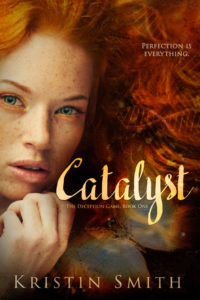 Title: Catalyst
Title: Catalyst
Author: Kristin Smith
Designer: Marya Heidel
Genre: Young adult, dystopian fiction
Graphics: The finely done illustration tells us several things at once. The protagonist is a teenaged girl. The book has something to do with her coming of age or maturing (the butterfly), and there is a scientific or genetic element to the story (the DNA strands).
The girl looks weary and wary. As it happens, she is one of only two students at her school who aren’t genetically modified. Everyone else is “perfect,” and that discrepancy is what the story hinges on. She is “odd girl out,” so to speak.
If the illustration has a weakness it is the disparity between the precision of the girl’s face and the haziness of the DNA strands and, less so, the butterfly. At thumbnail size the DNA looks like a blur, and the wings of the butterfly could be mistaken for two spheres or planets. It’s important for designers to keep in mind that, except on shelves of bookstores, book covers nowadays are seen first at thumbnail size, so each element has to be discernible even when small.
Typography: The title font is an unusual one. There is nothing particularly objectionable about it—it is legible enough—but it doesn’t suggest the genre. It might be just right for a book set in the Medieval era, given the font’s rough-hewn look, but it doesn’t seem to add anything here. Nevertheless, it has no real drawback (except see below).
The author name is in letters that are too thin, and they shouldn’t be in large and small caps. The same font could be used if it were in bold and all the letters the same height.
The series tagline, “The Deception Game, Book One,” is where one would expect a subtitle to be. It is so small as to be illegible even when the cover is seen at larger than thumbnail size. I would have put this tagline at the top in letters at least twice as tall. Again, there is the problem of using large and small caps.
There is a second tagline, “Perfection is Everything.” Where to put this? Before putting it anywhere, its size also should be increased substantially, and the period should be dropped, even though the tagline forms a complete sentence. Perhaps this tagline could be considered the subtitle and be placed immediately under the title, but that would bring back a spacing problem: to fit there, the text would have to be kept small.
The problem is with the descender to the Y. If the title were in all caps, there would be no descender, and the tagline/subtitle could stretch the full length of the title, allowing it to appear much larger.
As another alternative, the tagline/subtitle might be placed beneath the series tagline at the top, with its letters widely kerned to help distinguish the two lines from one another. Such a placement might necessitate lowering the girl’s face so the two lines of text don’t cover too much of her forehead.
Overall: This cover’s strength is the girl’s face, its weakness the size and placement of the text. At least the genre is plain enough. The cover makes it clear that this book is aimed at a young-adult audience and that it has something to do with the unexpected or the bizarre. Even as it stands, the cover deserves a solid B.
